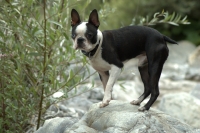This saying is known to be true by dog-owners all over the world. You see, lack of exercise is the source of many problems for dogs. So make sure your dog gets plenty of exercise each day.
Your dog may develop poor muscle tone, heart ailments, bone disorders, obesity, and even emotional problems if they don’t get adequate exercise.
The Benefits of Exercise
• Better rest (won’t be as nervous when left alone)
• Improved bone and joint health
• Improved heart and lung function
A lot of people think their dog just needs a big backyard to romp around in. This is definitely not the case. Dogs don’t exercise when they’re left outside by themselves. You’ll find them hanging out by themselves in the shade … waiting for you to play them!
Some Tips to Maximize Your Dog’s Workout
• Let your dog carry something when you go for walks (i.e. toy or basket).
• Let your dog play with other dogs!
• Teach your dog to retrieve (this is one of the best exercise).
Types of Exercise
Concentration Exercise
Hide treats inside an old wash-glove or in a rolled up towel, leave your dog to try and figure out how to get the treats, your dog will love this!
Brain Exercise
Hide treats underneath a bowl and see how your dog uses her creativity to turn the bowl and get to her treats.
Physical Exercise
Play fetch with your dog, take her on a speed walk, or take her swimming. These exercise are a great physical work-out for your pup!
Good Exercise vs. Bad Exercise
Good Exercise
The best types of exercise utilize the mind and body. Exercise should have a purpose and teach the dog that they can be calm and physically composed at the same time!
Bad Exercise
Bad exercises are exercises that could potentially harm your dog. Most people think that dogs can’t get too much exercise, but this is not the case.
Some examples of bad exercise would be having your dog jump high in the air to chase a toy. Your dog may end up landing awkwardly and hurt her legs.
Moderation
I’m sure you’ve heard the expressions all good things come in moderation. This applies to exercising your dog as well. Make a note of your dog’s body language. She’ll let you know when she is getting tired.
Beware of the Heat
Boston Terriers don’t have a very efficient cooling system. There short muzzles and black coat give them an enormous disadvantage to tolerating heat.
The top temperature for the average dog to be working or playing in should be about 85° F. But since Boston’s have the disadvantage mentioned above, this temperature can be too high for them.
In the House
You should try to avoid the routine of crating your dog all day, and then exercising them heavily as soon as you get home. This habit can lead to future behavior problems. It’s best to delay exercise for a few minutes after letting the dog out of the crate.
You should give your dog time to unwind after exciting exercise and before you crate them again.




